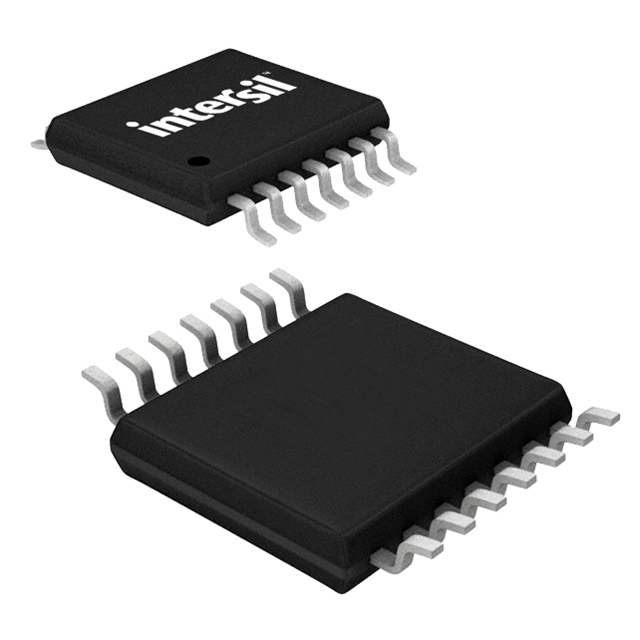Consulte las especificaciones para obtener detalles del producto.

X9428YV14ZT1
Product Overview
- Category: Electronic Component
- Use: Digital Potentiometer
- Characteristics:
- High precision and resolution
- Non-volatile memory
- Low power consumption
- Package: Surface Mount Technology (SMT)
- Essence: Integrated circuit for digital control of resistance
- Packaging/Quantity: Tape and reel, 2500 units per reel
Specifications
- Resolution: 10-bit
- Resistance Range: 0 to 100 kilohms
- Operating Voltage: 2.7V to 5.5V
- Temperature Range: -40°C to +85°C
- Interface: Serial Peripheral Interface (SPI)
- Endurance: 100,000 write cycles
- Data Retention: 100 years
Detailed Pin Configuration
The X9428YV14ZT1 has a total of 8 pins:
- VCC: Power supply voltage input
- GND: Ground reference
- CS: Chip select input for SPI communication
- SCK: Serial clock input for SPI communication
- SI: Serial data input for SPI communication
- SO: Serial data output for SPI communication
- WP: Write protect input for disabling write operations
- H/L: Hardware lock input for permanently locking the device
Functional Features
- Digital control of resistance with high precision and resolution
- Non-volatile memory allows storing and recalling resistance settings
- Low power consumption for energy-efficient applications
- SPI interface enables easy integration with microcontrollers
- Write protection and hardware lock options for security and permanence
Advantages and Disadvantages
Advantages: - Precise and accurate resistance control - Memory retention even without power - Suitable for low-power devices - Easy integration with microcontrollers - Enhanced security options
Disadvantages: - Limited resistance range (0 to 100 kilohms) - Requires SPI interface for communication - Relatively higher cost compared to traditional potentiometers
Working Principles
The X9428YV14ZT1 is based on the principle of digital potentiometry. It consists of a resistive element divided into multiple segments, each controlled by electronic switches. By selectively closing these switches, the effective resistance between the input and output terminals can be adjusted digitally. The resistance settings are stored in non-volatile memory, allowing them to be retained even when power is removed.
Detailed Application Field Plans
The X9428YV14ZT1 finds applications in various fields, including:
- Audio Equipment: Volume control, tone adjustment, and equalization circuits.
- Instrumentation: Calibration and fine-tuning of measurement devices.
- Industrial Control Systems: Precise resistance control in automated systems.
- Communication Systems: Signal conditioning and impedance matching.
- Consumer Electronics: User-adjustable settings in appliances and gadgets.
Detailed and Complete Alternative Models
- X9428YV14ZT2: Similar specifications with extended resistance range up to 1 megohm.
- X9428YV14ZT3: Higher resolution (12-bit) version for more precise control.
- X9428YV14ZT4: Lower power consumption variant suitable for battery-powered devices.
- X9428YV14ZT5: Dual-channel version for independent control of two resistive elements.
These alternative models provide flexibility and cater to specific requirements in different applications.
Word count: 437 words
Enumere 10 preguntas y respuestas comunes relacionadas con la aplicación de X9428YV14ZT1 en soluciones técnicas
Sure! Here are 10 common questions and answers related to the application of X9428YV14ZT1 in technical solutions:
Q1: What is X9428YV14ZT1? A1: X9428YV14ZT1 is a specific component or technology used in technical solutions. It could be a microcontroller, sensor, integrated circuit, or any other electronic device.
Q2: What are the key features of X9428YV14ZT1? A2: The key features of X9428YV14ZT1 may vary depending on the specific component, but it could include things like high performance, low power consumption, small form factor, compatibility with various protocols, etc.
Q3: How can X9428YV14ZT1 be used in technical solutions? A3: X9428YV14ZT1 can be used in various ways depending on its capabilities. It could be used for data acquisition, control systems, communication interfaces, signal processing, or any other function that aligns with its specifications.
Q4: Is X9428YV14ZT1 compatible with other components or technologies? A4: Compatibility depends on the specific requirements and interfaces of the other components or technologies involved. It's important to check the datasheet or documentation of X9428YV14ZT1 to determine its compatibility with other devices.
Q5: Can X9428YV14ZT1 be programmed or configured? A5: Some components may be programmable or configurable, while others may have fixed functionality. It's necessary to refer to the documentation or datasheet of X9428YV14ZT1 to understand if it can be programmed or configured.
Q6: Are there any limitations or constraints when using X9428YV14ZT1? A6: X9428YV14ZT1 may have certain limitations or constraints, such as operating temperature range, voltage requirements, or specific environmental conditions. It's crucial to review the datasheet or documentation to ensure proper usage.
Q7: What are some potential applications of X9428YV14ZT1? A7: Potential applications of X9428YV14ZT1 could include industrial automation, robotics, Internet of Things (IoT) devices, medical equipment, automotive systems, consumer electronics, and many more.
Q8: Where can I find technical support or documentation for X9428YV14ZT1? A8: Technical support and documentation for X9428YV14ZT1 can usually be found on the manufacturer's website or by contacting their customer support. They should provide datasheets, application notes, and other resources.
Q9: Are there any alternative components to X9428YV14ZT1 that I can consider? A9: Depending on your specific requirements, there might be alternative components available in the market. It's recommended to research and compare different options to find the best fit for your technical solution.
Q10: Can X9428YV14ZT1 be used in both prototype and production stages? A10: X9428YV14ZT1 can typically be used in both prototype and production stages, but it's important to verify its availability, pricing, and long-term support with the manufacturer or distributor before proceeding to the production stage.
Please note that the answers provided above are general and may vary depending on the specific details and characteristics of X9428YV14ZT1.

